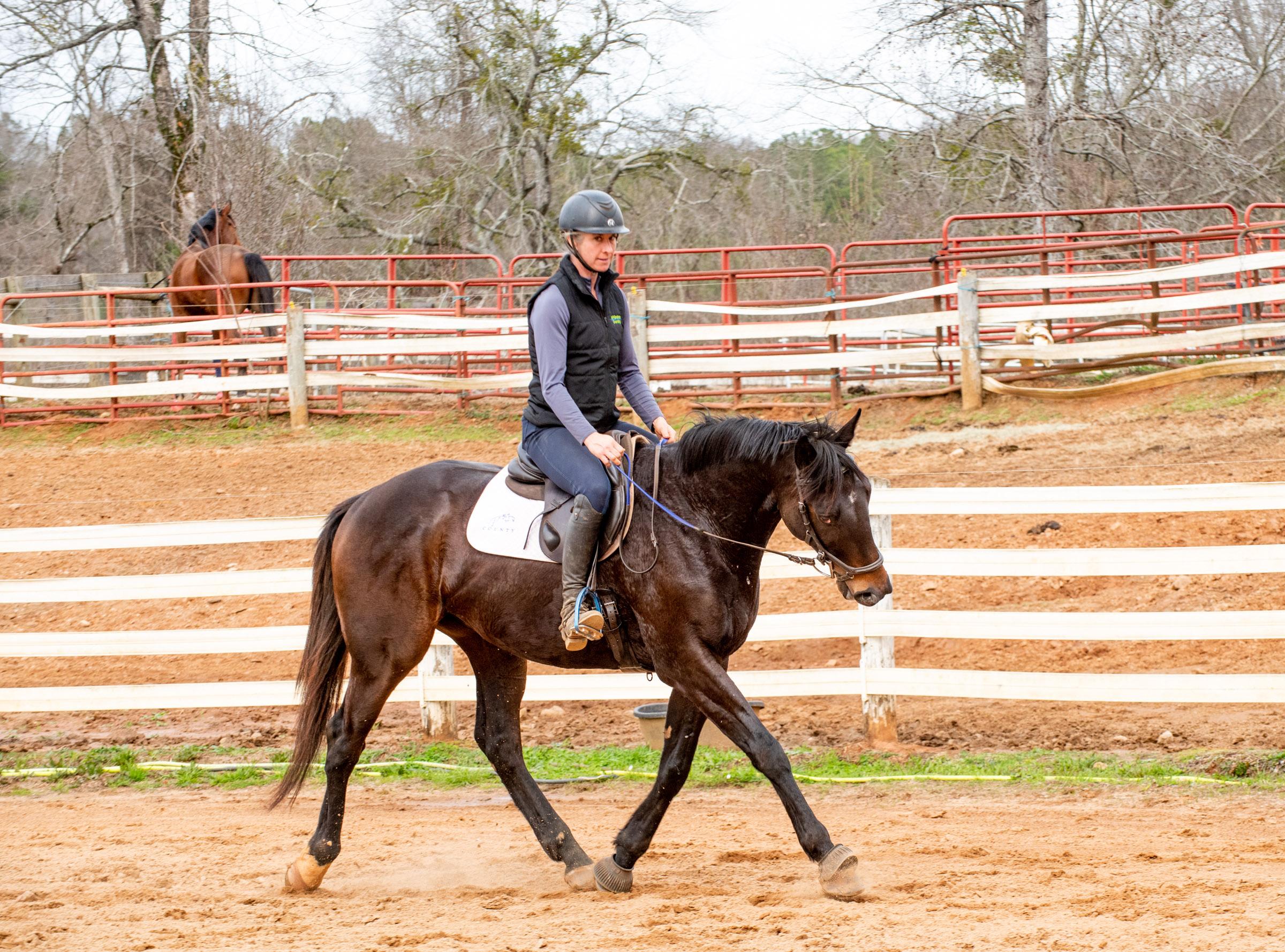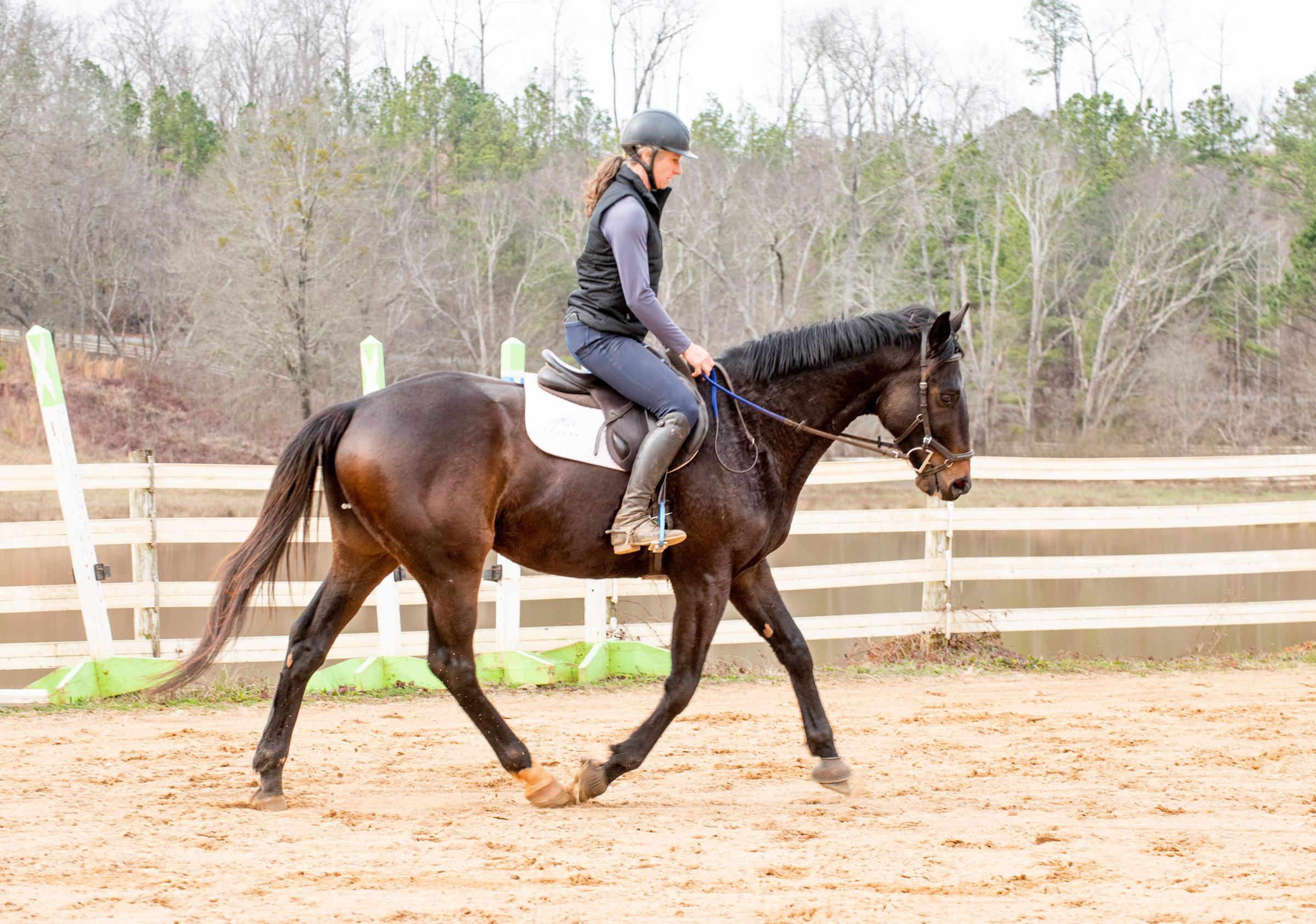
Thoroughbred Logic: Fixing the Head Tilt
“Correcting head tilts, therefore, comes in at the point where the horse is pushing from behind and elevating their shoulder (even if they can’t hold this strong position for too long). Then you can start to ask them to straighten out. Easier said than done, of course.”
Welcome to the next installment of Thoroughbred Logic. In this weekly series, Anthropologist and trainer Aubrey Graham, of Kivu Sport Horses, offers insight and training experience when it comes to working with Thoroughbreds (although much will apply to all breeds). This week, come along for the ride as Aubrey offers her logic on how to fix the head tilt.
Some horses make life easy. Their bodies are in proper alignment, and as “A” students, they not only are willing and happy to try, but they also regularly get the right answer. So you sit up tall, lift your hands a touch, and add leg and in response, they lift through their core, step their hind under them, and begin to become round(er). Better yet, they stay straight, soft, and willing. Cool.

Lottie (Hatch Gate) has stunning movement and a willingness to come over her back correctly that rarely fails to impress. Photo by Alanah Giltmier.
Easy, right?
I wish.
Even for educated horses, there are a slew of responses that might not quite be “correct.” For instance, there is the “I’m sorry, did you say something?” response, as the horse sticks their proverbial fingers in their ears and carries on like nothing was requested. This answer shows up when the knowledgable horse absolutely knows the right answer but just isn’t convinced it is necessary… (ahem, Forrest and Ranger). Among other options, there is also the simple “I don’t like how you asked” middle finger made manifest by things like a side skitter, head toss or kick out (here’s looking at you, Rhodie).

Cowboy Night (Ranger) keeping his fingers out of his ears and staying soft and correct while putting in a lovely dressage test in the Rolex Stadium during the 2021 MegaMakeover. Photo by Alexa Wegner.
For greener horses, getting the right answer is as much about their willingness to make an effort as it is their body’s ability to produce the correct shape and alignment. Early on in the re/training process, possible answers often include the range of “I’m trying but this is hard” efforts:
The horse will aim to come round, but go too low, dropping onto their forehand or curling below the bit. They might lock their TMJ or their jaw and try to lean on what should be soft rein contact. They might speed up or slow down to avoid having to bend through their hocks and sit under themselves. They might simply collapse a shoulder or their haunches and fall in. They might bobble their head in the contact, flick their nose, or channel an 80’s hair band and outright head bang. And finally, they might sit through their hind end, lift their core, elevate their shoulder (and your hopes), settle onto contact and … drumroll… throw their poll one direction and their nose the other. Ahhhhh, the dreaded head tilt.

Madigan Cat showing off his temporary head tilt but also his improved carriage in Feb. 2023. Photo by Alanah Giltmier.
So, while there are training solutions for all of the above issues (namely, ignore their head antics, sit up, stay soft at your elbows, and keep the horse balanced and straight between your legs and your reins), today we specifically take on this head tilt thing.
A few notes of context: When I am putting early-on-restarting rides on Thoroughbreds off the track, I don’t care about a tilt… or their head…or their nose. Folks will regularly hear me riding around going, “Yes, I see your head tilt, we’ll deal with that later,” but I don’t bother trying to fix it yet (just like I don’t bother to try to “get them on the bit” immediately either).

Madigan Cat, nose out and defensive but listening during his first post-track ride in late November 2022 – definitely not the time to try to correct anything. Photo by Alanah Giltmier.
As far as I am concerned, a horse’s head and neck are symptoms of their body’s position and alignment. I never really care if a horse’s head is down — rather, I care if they have their hind end under them and have engaged their core. Once they do that, the shoulder lifts and the head and neck drop into place. Riding the horses from their hind legs forward helps take the stress off of all the comical ridiculousness that shows up early on with their head. Get the body right, and the rest will largely fall into place.
Correcting head tilts, therefore, comes in at the point where the horse is pushing from behind and elevating their shoulder (even if they can’t hold this strong position for too long). Then you can start to ask them to straighten out. Easier said than done, of course.

Hind end up under him, Madigan shows off the initial stages of learning to go forward and come round. I don’t care that he isn’t quite “on the bit” here – the hind parts of the puzzle are falling into place nicely. Photo by Alanah Giltmier.
I might be full of random metaphors when I teach, but I often ask students to think about horses like the old wooden snake toys. Big movements cause the whole thing to wiggle, but careful, calculated movements from the back end can allow you to line up all the joints so that they are straight.
Most riders seem to want to address the nose in order to fix the head tilt. If the poll is right and the nose is left, I’ll find them taking up rein on the right side in an effort to get the horse to put his or her nose back in the right (correctly aligned) spot. However, for most horses, all this does is cause them to settle more into their tilt. Fixing it — just like getting the front end to do pretty much anything — comes from further back on the body.

Thanks, Amazon.com for the fantastic wooden snake photo.
Like trying to get the snake straight, I think from the back forward — first about the hind feet: are they under the horse and is the critter pushing over their back? If not, I don’t bother with the head tilt — like at all. Once they are pushing and driving through a nice rhythmic gait, I’ll work on the tilt by moving the shoulder behind the nose.
To move the shoulder behind the nose in our example of nose left/poll right, I’ll push the shoulder to a more central/left position. I’ll open my left rein in the direction of their nose and perhaps counterintuitively, gently increase contact. Instead of trying to pull the nose back to the right, I’ll make a soft “wall” with my right leg and right rein (next to the neck, not across it) in order to stand the horse up straighter and encourage their shoulders to move to the left. Usually, I’ll need to hold them steady there with my aids for a bit until they take a breath and settle, but also usually, that effort sorts out the garden variety head tilt.
Now… here’s where this does not work: Pain. If a horse is head tilting because of issues with their teeth or TMJ or neck/back problems, training won’t fix the issue. So if a head tilt is not a temporary response to an ask, one might need to see a dentist, vet, chiropractor, body worker etc. However, if the tilt is just an “I don’t quite understand the question and this is how I am going to answer right now” response, keep the handy “push the shoulder behind the nose” concept in your back pocket.
For most of my green beans who at some point decide to try the tilt, strength and correct riding/training tend to make it a non-issue. And of course, none of that is “fixed” in one day. Muscles can be strengthened little by little until a horse is going increasingly correctly for longer periods of time (see Amelia’s example below). But as with everything, it is likely a game of two steps forward… one back; two steps forward, 14 back… five steps forward, none back… and so on. Because frankly, if we wanted it to be simple(r), we’d be working on machines.
Enjoy the rides folks… and here’s to more sunny (or hell, at least dry) days in the saddle.








